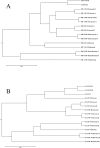Dynamics and Reversibility of the DNA Methylation Landscape of Grapevine Plants (Vitis vinifera) Stressed by In Vitro Cultivation and Thermotherapy
- PMID: 25973746
- PMCID: PMC4431845
- DOI: 10.1371/journal.pone.0126638
Dynamics and Reversibility of the DNA Methylation Landscape of Grapevine Plants (Vitis vinifera) Stressed by In Vitro Cultivation and Thermotherapy
Abstract
There is relatively little information concerning long-term alterations in DNA methylation following exposure of plants to environmental stress. As little is known about the ratio of non-heritable changes in DNA methylation and mitotically-inherited methylation changes, dynamics and reversibility of the DNA methylation states were investigated in grapevine plants (Vitis vinifera) stressed by in vitro cultivation. It was observed that significant part of induced epigenetic changes could be repeatedly established by exposure to particular planting and stress conditions. However, once stress conditions were discontinued, many methylation changes gradually reverted and plants returned to epigenetic states similar to those of maternal plants. In fact, in the period of one to three years after in vitro cultivation it was difficult to distinguish the epigenetic states of somaclones and maternal plants. Forty percent of the observed epigenetic changes disappeared within a year subsequent to termination of stress conditions ending and these probably reflect changes caused by transient and reversible stress-responsive acclimation mechanisms. However, sixty percent of DNA methylation diversity remained after 1 year and probably represents mitotically-inherited epimutations. Sequencing of regions remaining variable between maternal and regenerant plants revealed that 29.3% of sequences corresponded to non-coding regions of grapevine genome. Eight sequences (19.5%) corresponded to previously identified genes and the remaining ones (51.2%) were annotated as "hypothetical proteins" based on their similarity to genes described in other species, including genes likely to undergo methylation changes following exposure to stress (V. vinifera gypsy-type retrotransposon Gret1, auxin-responsive transcription factor 6-like, SAM-dependent carboxyl methyltransferase).
Conflict of interest statement
Figures


Similar articles
-
Variation in DNA methylation patterns of grapevine somaclones (Vitis vinifera L.).BMC Plant Biol. 2008 Jul 15;8:78. doi: 10.1186/1471-2229-8-78. BMC Plant Biol. 2008. PMID: 18627604 Free PMC article.
-
Epigenomics in stress tolerance of plants under the climate change.Mol Biol Rep. 2023 Jul;50(7):6201-6216. doi: 10.1007/s11033-023-08539-6. Epub 2023 Jun 9. Mol Biol Rep. 2023. PMID: 37294468 Review.
-
Effect of Vitis vinifera zygotic embryo cryopreservation and post-cryopreservation on the gene expression of DNA demethylases.Cryobiology. 2024 Sep;116:104947. doi: 10.1016/j.cryobiol.2024.104947. Epub 2024 Aug 14. Cryobiology. 2024. PMID: 39084504
-
Uncovering the role of DNA methyltransferases in grapevine - Plasmopara viticola interaction: From genome-wide characterization to global methylation patterns.Gene. 2022 Aug 30;837:146693. doi: 10.1016/j.gene.2022.146693. Epub 2022 Jun 20. Gene. 2022. PMID: 35738444
-
Age-associated alterations in the somatic mutation and DNA methylation levels in plants.Plant Biol (Stuttg). 2016 Mar;18(2):185-96. doi: 10.1111/plb.12375. Epub 2015 Aug 12. Plant Biol (Stuttg). 2016. PMID: 26211365 Review.
Cited by
-
Effect of Cryopreservation and Post-Cryopreservation Somatic Embryogenesis on the Epigenetic Fidelity of Cocoa (Theobroma cacao L.).PLoS One. 2016 Jul 12;11(7):e0158857. doi: 10.1371/journal.pone.0158857. eCollection 2016. PLoS One. 2016. PMID: 27403857 Free PMC article.
-
Epigenetics for Crop Improvement in Times of Global Change.Biology (Basel). 2021 Aug 11;10(8):766. doi: 10.3390/biology10080766. Biology (Basel). 2021. PMID: 34439998 Free PMC article. Review.
-
Epigenetic Modulating Chemicals Significantly Affect the Virulence and Genetic Characteristics of the Bacterial Plant Pathogen Xanthomonas campestris pv. campestris.Genes (Basel). 2021 May 25;12(6):804. doi: 10.3390/genes12060804. Genes (Basel). 2021. PMID: 34070403 Free PMC article.
-
Emerging Roles of Epigenetics in Grapevine and Winegrowing.Plants (Basel). 2024 Feb 13;13(4):515. doi: 10.3390/plants13040515. Plants (Basel). 2024. PMID: 38498480 Free PMC article. Review.
-
Traditional Approaches and Emerging Biotechnologies in Grapevine Virology.Viruses. 2023 Mar 24;15(4):826. doi: 10.3390/v15040826. Viruses. 2023. PMID: 37112807 Free PMC article. Review.
References
-
- Popescu CF, Falk A, Glimelius K (2002) Application of AFLPs to characterize somaclonal variation in anther derived grapevines. Vitis 41: 177–182.
-
- Xu M, Li X, Korban SS (2004) DNA-methylation alterations and exchanges during in vitro cellular differentiation in rose (Rosa hybrida L.). Theor Appl Genet 109: 899–910. - PubMed
-
- Li X, Yu X, Wang N, Feng Q, Dong Z, Liu L, et al. (2007) Genetic and epigenetic instabilities induced by tissue culture in wild barley (Hordeum brevisubulatum (Trin.) Link). Plant Cell Tiss Org Cult 90: 153–168.
-
- Gribaudo I, Mannini F, Lisa A, Cuozzo D (2000) Phenotypical modifications of micropropagated grapevines. Acta Hortic 530: 231–236.
Publication types
MeSH terms
Substances
LinkOut - more resources
Full Text Sources
Other Literature Sources
Research Materials

